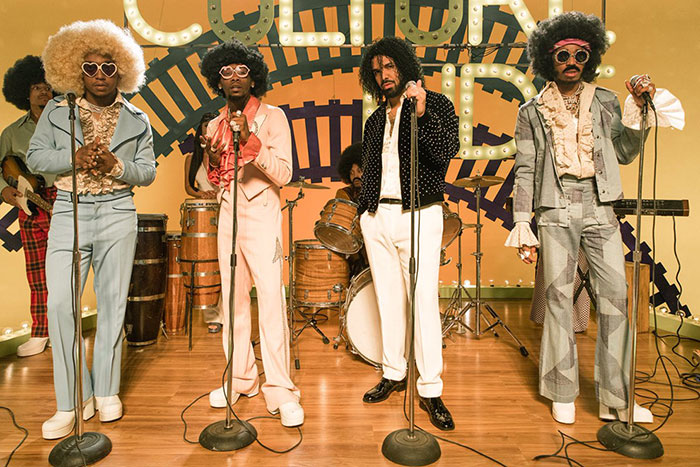When discussing the Migos’ 2017 “Culture” album with Fader, Offset said, “The new album title is about the culture of hip-hop music. It’s time to let the culture be known. It’s time to claim it. And it’s time to claim that we are the Migos, and for people to understand that this is what we did. We did a lot for music. Migos is the culture.”
Offset was obviously talking about the music itself, but this past week, I’ve been thinking about the group’s visuals. Almost immediately upon seeing it, I realized that the Migos’ recently released video for “Walk It Talk It” is the closest thing we have to the fully realized vision of the “Culture” concept so far.
Emulating the look and ethos of “Soul Train,” the Migos and director Daps refer to influential black musicians like James Brown and Rick James while reclaiming the aesthetics of that era. Quavo, Offset, Takeoff and special guest Drake saunter on stage in their gaudy 1970s outfits. A seemingly all-black audience dances and roller-skates around the set. Host Ron Delirious (played by Jamie Foxx) excitedly introduces the Migos.
 In these ways, and in the simple fact that the Migos are having so much fun, the stage of the fictional “Culture Ride” show becomes a space for “black joy,” a phrase used by Nelson George to describe “Soul Train.”
In these ways, and in the simple fact that the Migos are having so much fun, the stage of the fictional “Culture Ride” show becomes a space for “black joy,” a phrase used by Nelson George to describe “Soul Train.”
Back to Offset’s quote – while it seems a bit vague and circular to say that “Migos is the culture,” there’s a suggestion of a vision of the future. With an awareness that the Migos follow a cultural tradition but also plays a role in creating the future of that tradition, they are, in Quavo’s words, putting their “address on it.”
Migos proved this awareness by naming their most popular series of albums “Culture” and by rapping in a language, with a flow and about subjects that were uniquely relevant to the culture of north Atlanta, they brought to the forefront of music.
Yet, in the visuals Migos released before, the full vision of this “Culture” concept was obscured.
Migos relied on the tropes of mainstream hip-hop — objectified and scantily-clad women with expensive alcohol and far more expensive vehicles — in an effort to market themselves to that same mainstream audience and prove themselves to rap’s big names.
“Slippery,” “Bad and Boujee” and “Get Right Witcha” all fit this mainstream mold almost exactly. In them, Offset, Quavo and Takeoff flaunt money, ride around in G-Wagons and Bentleys and rap while sitting next to women in bathing suits, all of which distracts from any larger point they are trying to make.
Two videos, those for “T-Shirt” and “Deadz,” use the same tropes, but they also give a glimpse into the fuller vision of “Culture” and hint at Migos’ social consciousness and desire to reject the mold set for them.
For example, in the “Deadz” video, an all-black orchestra playing the song’s opening melody puts black excellence on full display and subverts the idea of classical music as an outdated, European genre, but when Quavo begins rapping in an opulent mansion and pouring vodka from a ritzy-looking bottle, it feels like the Migos are yet again trying to appeal to the image of mainstream hip-hop.
But after the success of “Culture,” the Migos got the fame and the power and became arbiters of hip-hop culture.
As the first visual for “Culture II,” the Migos and director Sing J. Lee worked together to create a short film centered around the song “Stir Fry.” There’s a lot going on in the video — a mysterious struggle between two gangs, the Migos running a Chinese restaurant named after themselves, Quavo’s bad acting and some serious cultural appropriation.
As Josh M. Grossman of The Harvard Crimson notes, the Migos “do their best to imitate every trope of a ‘Chinese’ movie” and do a lot of it wrong. They misinterpret the principle of kung fu martial arts and show they have no idea how Mahjong works.
Other critics have pointed out that the video alludes to the blending of Blaxploitation and martial arts movies that occurred in the 1970s and is part of a larger trend of black artists using conventions of martial arts movies they grew up watching. Kendrick Lamar’s “Kung Fu Kenny” personality is the most notable example of this trend.
But, even if the Migos are alluding to or parodying these movies, their history of anti-Asian racism within their lyrics undercuts any potential effectiveness of this video. Just as with their previous reliance on hip-hop tropes, the Migos confuse and distract from any more profound purpose of their music and visuals.
This was all before “Walk It Talk It” and the “Culture Ride” video, in which that vision finally achieved its full form and the Migos finally found their groove. However, there are still remnants of the Migos’ earlier work. For example, though women are wearing the less-revealing clothing of the ‘70s, they are still relegated to objectified roles.
Because of this, “Walk It Talk It” is far from perfect and is still offensive in many of the same ways that the Migos’ other work is. But what’s important is that this is the most complex, nuanced and fully fleshed-out version of the “Culture” vision that’s made its way onto the screen.






